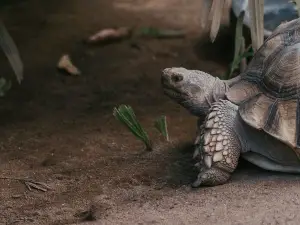
Odd behavior in any of your pets, your tortoise included, would worry any pet owner, a tortoise drooling is definitely a sign that there is something going on with your reptile.
This article looks into why your tortoise may be drooling.
Table of Contents
Tortoise drooling:
Tortoises are lovely pets to own and raise and any thought of your little pet being sick and suffering is likely highly distressing to you as an owner.
You may think that your drooling tortoise is sick, this article looks into why your little pet may be doing this:
Herpes virus:
Not only can humans get herpes, but your tortoise can too and this may be why your pet is drooling at its mouth.
The first signs of this condition in your pet are lesions developing on the lining of your pet’s mouth.
As time goes on, and as the condition progresses, your pet will start to develop a thick off-white or yellow membrane on the inside of its mouth and then the drooling will start.
Other signs that indicate your pet has this condition are closed or swollen eyes, an audible gurgling noise when the animal breathes, gasping, open mouth breathing, and an inflamed nare lining.
What to do:
Taking your pet to the vet, if you suspect that it has this condition, is recommended.
The vet will clean your pet’s mouth by removing the membrane that has built up on the inside of the animal’s mouth. The vet will then give your pet antiviral medications to fight off its illness.
These medications may be delivered directly into the animal’s stomach through a feeding tube.
Stomatitis:
Another reason why your pet tortoise may be drooling may be that the animal has a condition called stomatitis, also called mouth rot.
This is a bacterial infection that affects the animal’s oral cavity. The infection causes the animal’s mouth to become inflamed and this inflammation will cause trauma or damage to the animal’s mouth.
There are a variety of signs that may indicate that your pet has this condition but unfortunately, these signs usually only come up once the illness has progressed.
One such sign of this condition in your pet is drooling, this can be seen once the condition has settled in.
Other signs of this condition include lethargy, walking around the enclosure more than usual, becoming defensive or shy all of a sudden, a loss of appetite, inflammation inside the animal’s mouth, bleeding, and ulcers in the mouth.
A tortoise who is suffering from this condition, who is left untreated, will soon take a turn for the worse.
The illness can spread down into the animal’s esophagus, the animal’s food pipe, and even into the animal’s lungs.
What to do:
This condition can be quite serious and would need veterinary attention, taking your pet to a herp vet is recommended over taking your pet to a regular vet.
Your vet will ask you questions about the animal’s husbandry, its diet, and the history of when the animal’s strange behavior started.
Once it is established that your pet has this condition your vet will treat it.
If you enjoyed this article then you may also be interested in other turtle/tortoise related articles. Here are some articles that you may be interested in: Why Is My Tortoise Panting?, Hermann Tortoise Wheezing, Russian Tortoise Puffy Eyes, Why Is My Tortoise Screaming?, Why Does My Tortoise Walk Into Walls?

